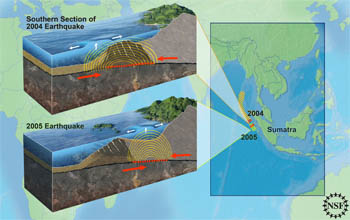All Images
News Release 10-116
New Findings Indicate Sediment Composition Affected the Strength of Sumatran Earthquake
International research team studied differences between 2004 and 2005 quakes
This material is available primarily for archival purposes. Telephone numbers or other contact information may be out of date; please see current contact information at media contacts.

Researchers found differences between the rocks in the regions where the 2004 and 2005 Sumatran earthquakes occurred. In the southern part of the region where the 2004 earthquake occurred, the earthquake rupture began closer to shore and did not reach as far seaward. Comparatively, the 2005 earthquake ruptured farther seaward beneath a thick wedge of compacted sedimentary rocks. These differences help explain why the 2004 earthquake and ensuing tsunami were more severe than subsequent events in 2005.
Credit: Nicolle Rager Fuller, National Science Foundation
Download the high-resolution JPG version of the image. (455 KB)
Use your mouse to right-click (Mac users may need to Ctrl-click) the link above and choose the option that will save the file or target to your computer.
Geophysicist Sean Gulick of the University of Texas at Austin was the guest at the webcast, "Researching Sumatra's Earthquakes," hosted by the National Science Foundation. Gulick discussed the July 9 Science publication "Contrasting decollement and prism properties over the Sumatra 2004/2005 earthquake rupture boundary."
Credit: National Science Foundation/ University of Texas at Austin

The research described in this publication was performed in the Indian Ocean off Sumatra while aboard the German Research Vessel (RV) Sonne.
Credit: Science Party of SO-198-2
Download the high-resolution JPG version of the image. (655 KB)
Use your mouse to right-click (Mac users may need to Ctrl-click) the link above and choose the option that will save the file or target to your computer.

To study the rock layers below the seabed, researcher Jamie Austin of University of Texas at Austin and vessel crew deploy a sound source (airguns) and a listening cable 'streamer' to record the sound waves as they are reflected back towards the surface.
Credit: Science Party of SO-198-2
Download the high-resolution JPG version of the image. (631 KB)
Use your mouse to right-click (Mac users may need to Ctrl-click) the link above and choose the option that will save the file or target to your computer.

Researcher Sean Gulick of the University of Texas at Austin works to set up experimental equipment in the Indian Ocean off Sumatra. To 'map' the area below the seafloor, airguns are fired as the ship sails along while the trailing 2.5 kilometer streamer records reflections from the subsurface using hydrophones organized into listening channels.
Credit: Science Party of SO-198-2
Download the high-resolution JPG version of the image. (627 KB)
Use your mouse to right-click (Mac users may need to Ctrl-click) the link above and choose the option that will save the file or target to your computer.

This photo shows an airgun array going off. Researchers used the airguns as a sound source to image below the seafloor off the coast of Sumatra. These airguns are fired every 50 meters as the ship sails along an imaging profile.
Credit: Science Party of SO-198-2
Download the high-resolution JPG version of the image. (626 KB)
Use your mouse to right-click (Mac users may need to Ctrl-click) the link above and choose the option that will save the file or target to your computer.

This image shows the fantail of the RV Sonne. In this photo, the seismic reflection streamer used to record the sound waves is missing--studies were delayed while the streamer was stuck in customs.
Credit: Science Party of SO-198-2
Download the high-resolution JPG version of the image. (703 KB)
Use your mouse to right-click (Mac users may need to Ctrl-click) the link above and choose the option that will save the file or target to your computer.

This research is detailed in the July 9, 2010 issue of Science.
Credit: Copyright AAAS 2010
Download the high-resolution JPG version of the image. (22 KB)
Use your mouse to right-click (Mac users may need to Ctrl-click) the link above and choose the option that will save the file or target to your computer.
